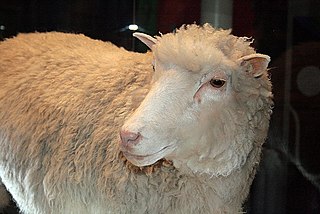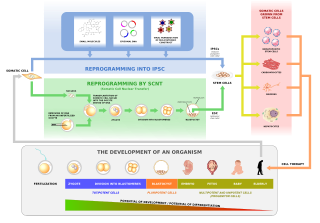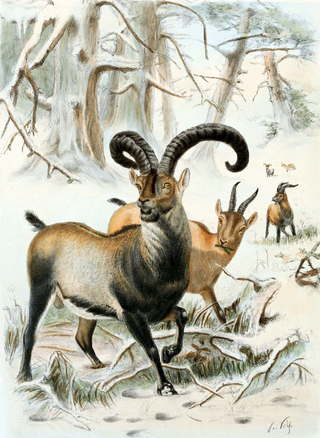
Cloning is the process of producing individual organisms with identical genomes, either by natural or artificial means. In nature, some organisms produce clones through asexual reproduction; this reproduction of an organism by itself without a mate is known as parthenogenesis. In the field of biotechnology, cloning is the process of creating cloned organisms of cells and of DNA fragments.

Dolly was a female Finn-Dorset sheep and the first mammal that was cloned from an adult somatic cell. She was cloned by associates of the Roslin Institute in Scotland, using the process of nuclear transfer from a cell taken from a mammary gland. Her cloning proved that a cloned organism could be produced from a mature cell from a specific body part. Contrary to popular belief, she was not the first animal to be cloned.

Human cloning is the creation of a genetically identical copy of a human. The term is generally used to refer to artificial human cloning, which is the reproduction of human cells and tissue. It does not refer to the natural conception and delivery of identical twins. The possibilities of human cloning have raised controversies. These ethical concerns have prompted several nations to pass laws regarding human cloning.

An embryo is the initial stage of development for a multicellular organism. In organisms that reproduce sexually, embryonic development is the part of the life cycle that begins just after fertilization of the female egg cell by the male sperm cell. The resulting fusion of these two cells produces a single-celled zygote that undergoes many cell divisions that produce cells known as blastomeres. The blastomeres are arranged as a solid ball that when reaching a certain size, called a morula, takes in fluid to create a cavity called a blastocoel. The structure is then termed a blastula, or a blastocyst in mammals.

Przewalski's horse, also called the takhi, Mongolian wild horse or Dzungarian horse, is a rare and endangered horse originally native to the steppes of Central Asia. It is named after the Russian geographer and explorer Nikolay Przhevalsky. Once extinct in the wild, since the 1990s it has been reintroduced to its native habitat in Mongolia in the Khustain Nuruu National Park, Takhin Tal Nature Reserve, and Khomiin Tal, as well as several other locales in Central Asia and Eastern Europe.

In genetics and developmental biology, somatic cell nuclear transfer (SCNT) is a laboratory strategy for creating a viable embryo from a body cell and an egg cell. The technique consists of taking a denucleated oocyte and implanting a donor nucleus from a somatic (body) cell. It is used in both therapeutic and reproductive cloning. In 1996, Dolly the sheep became famous for being the first successful case of the reproductive cloning of a mammal. In January 2018, a team of scientists in Shanghai announced the successful cloning of two female crab-eating macaques from foetal nuclei.
In cellular biology, a somatic cell, or vegetal cell, is any biological cell forming the body of a multicellular organism other than a gamete, germ cell, gametocyte or undifferentiated stem cell. Somatic cells compose the body of an organism and divide through mitosis.

Nuclear transfer is a form of cloning. The step involves removing the DNA from an oocyte, and injecting the nucleus which contains the DNA to be cloned. In rare instances, the newly constructed cell will divide normally, replicating the new DNA while remaining in a pluripotent state. If the cloned cells are placed in the uterus of a female mammal, a cloned organism develops to term in rare instances. This is how Dolly the Sheep and many other species were cloned. Cows are commonly cloned to select those that have the best milk production. On 24 January 2018, two monkey clones were reported to have been created with the technique for the first time.
Polly and Molly, two ewes, were the first mammals to have been successfully cloned from an adult somatic cell and to be transgenic animals at the same time. This is not to be confused with Dolly the Sheep, the first animal to be successfully cloned from an adult somatic cell where there wasn’t modification carried out on the adult donor nucleus. Polly and Molly, like Dolly the Sheep, were cloned at the Roslin Institute in Edinburgh, Scotland.
Snuppy was an Afghan hound, the first dog clone. The puppy was created using a cell from an ear from an adult Afghan hound and involved 123 surrogate mothers, of which only two produced pups. The Department of Theriogenology and Biotechnology at Seoul National University, which cloned Snuppy, was led by Woo Suk Hwang. Snuppy has since been used in the first known successful breeding between cloned canines after his sperm was used to artificially inseminate two cloned females, which resulted in the birth of 10 puppies in 2008. In 2017, 4 clones of Snuppy were made by Sooam, and were the first clones made of a cloned dog, to investigate potential health effects of cloning.

The dog is a domesticated descendant of the wolf. Also called the domestic dog, it is derived from extinct gray wolves, and the gray wolf is the dog's closest living relative. The dog was the first species to be domesticated by humans. Experts estimate that hunter-gatherers domesticated dogs more than 15,000 years ago, which was before the development of agriculture. Due to their long association with humans, dogs have expanded to a large number of domestic individuals and gained the ability to thrive on a starch-rich diet that would be inadequate for other canids.
The Missyplicity Project was a project devoted to cloning Joan Hawthorne and John Sperling's dog, a border collie and husky mix. Missy died on July 6, 2002, at the age of 15.
Megan and Morag, two domestic sheep, were the first mammals to have been successfully cloned from differentiated cells. They are not to be confused with Dolly the sheep which was the first animal to be successfully cloned from an adult somatic cell or Polly the sheep which was the first cloned and transgenic animal. Megan and Morag, like Dolly and Polly, were cloned at the Roslin Institute in Edinburgh, Scotland in 1995.
A frozen zoo is a storage facility in which genetic materials taken from animals are stored at very low temperatures (−196 °C) in tanks of liquid nitrogen. Material preserved in this way can be stored indefinitely and used for artificial insemination, in vitro fertilization, embryo transfer, and cloning. There are a few frozen zoos across the world that implement this technology for conservation efforts. Several different species have been introduced to this technology, including the Pyrenean ibex, Black-footed ferret, and potentially the white rhinoceros.

De-extinction is the process of generating an organism that either resembles or is an extinct species. There are several ways to carry out the process of de-extinction. Cloning is the most widely proposed method, although genome editing and selective breeding have also been considered. Similar techniques have been applied to certain endangered species, in hopes to boost their genetic diversity. The only method of the three that would provide an animal with the same genetic identity is cloning. There are benefits and drawbacks to the process of de-extinction ranging from technological advancements to ethical issues.

Cryoconservation of animal genetic resources is a strategy wherein samples of animal genetic materials are preserved cryogenically.

Zhong Zhong and Hua Hua are a pair of identical crab-eating macaques that were created through somatic cell nuclear transfer (SCNT), the same cloning technique that produced Dolly the sheep in 1996. They are the first cloned primates produced by this technique. Unlike previous attempts to clone monkeys, the donated nuclei came from fetal cells, not embryonic cells. The primates were born from two independent surrogate pregnancies at the Institute of Neuroscience of the Chinese Academy of Sciences in Shanghai.
Revive & Restore is a nonprofit wildlife conservation organization focused on use of biotechnology in conservation. Headquartered in Sausalito, California, the organization's mission is to enhance biodiversity through the genetic rescue of endangered and extinct species. The organization was founded by Stewart Brand and his wife, Ryan Phelan.
Sinogene Biotechnology is a biotechnology company focusing on animal cloning technology for consumers. Their services include dog, cat, and horse cloning.










